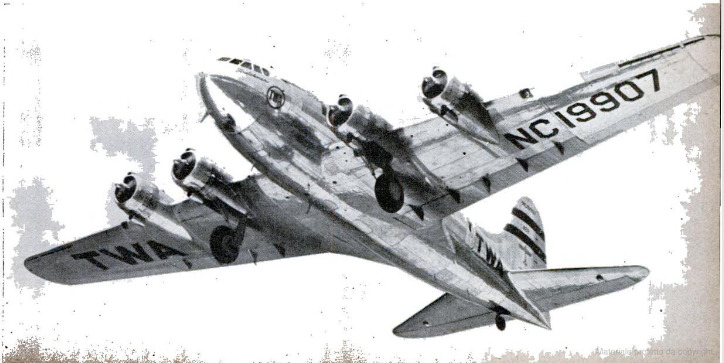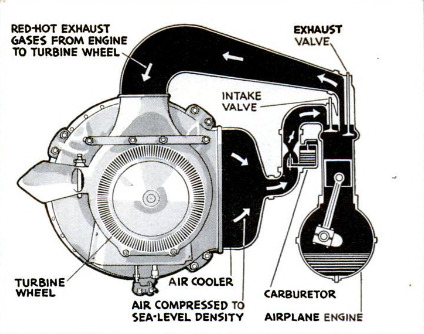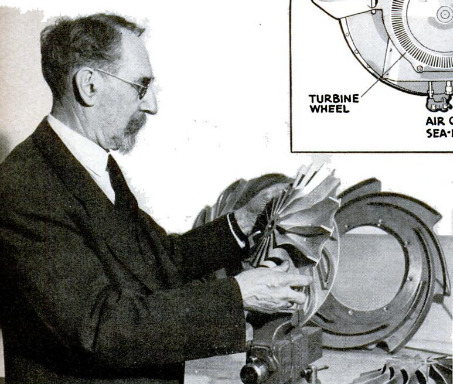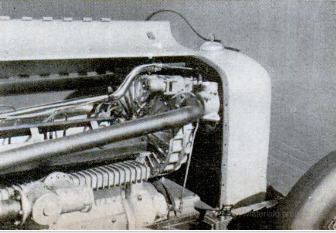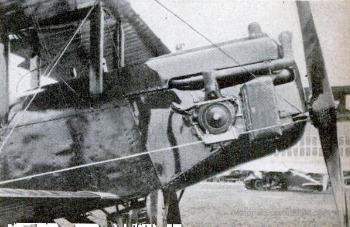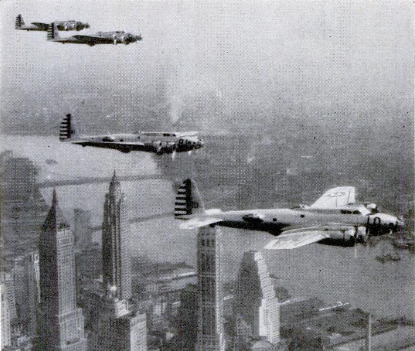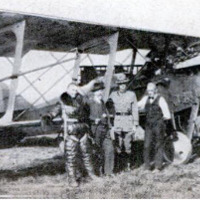-
Title (Dublin Core)
-
He harnessed a Tornado and developed the modern airplane supercharger
-
Article Title and/or Image Caption (Dublin Core)
-
Title: He harnessed a Tornado and developed the modern airplane supercharger
-
extracted text (Extract Text)
-
PROBABLY the happiest man in America
today is Dr. Sanford A. Moss, the man
who developed the supercharger, the
device which makes possible the altitude,
speed, and range of the modern airplane.
His greatest creation, the turbo-super-
charger, at last has come into its own, after
twenty years of delay, as a basis for strato-
sphere flying. It has become one of the most
important focal points in America’s sudden
war effort. No effort or expense is being
spared to push its mass production. At last
the sky is really the limit.
‘Twenty-three years ago, in order to help
beat the Kaiser, Dr. Moss harnessed up a
red-hot tornado, sheathed it in heat-resist-
ant metal, and hitched it up to a Liberty
‘motor at McCook Field, Dayton, Ohio. Shel-
tered behind a barricade of sandbags, he
opened the throttle up wide. With a wild
roar of broken connecting rods the airplane
engine disintegrated. The spark plugs tore
out through the roof.
Dr. Moss, a small scientific gentleman
with a Vandyke beard, knew perfectly well
what he was doing in this seemingly irra-
tional behavior, just as any airplane pilot
today knows that you are likely to tear your
engine to pieces if you open up wide at sea
level with a Moss supercharger. He was
giving the turbo-supercharger its first dem-
onstration, and he did his violent deed at the
insistence of a skeptical group of Air Corps
engineers, to convince them that this odd
contraption of his was worthy of an official
test at the top of Pike's Peak, in the rare-
fied atmosphere it was built to conquer. At
half throttle they had refused to be con-
vinced.
On Pike's Peak, in September, 1018, the
turbo-supercharger proved itself. In those
days an airplane engine lost power rapidly
as it gained altitude because, as atmospheric
pressure fell, less oxygen was sucked in to
mix with the fuel in the combustion cham-
bers. The supercharger was a centrifugal
compressor, or fan, which forced air in sea-
level quantities into the engine's carburetor.
In the words of Dr. Moss, it “kidded the en-
gine into thinking it was at sea level.” The
compressor was revolved by a turbine driven
by a whirlwind of flaming fumes from the
engine's exhaust.
The test Liberty motor, which had pro-
duced 350 horsepower at Dayton, would give
only 230 horsepower at the 14,000-foot alti-
tude of Pike's Peak. But when Dr. Moss
cut in his supercharger, it gave 356 horse-
power. And this full power was much more
valuable than at lower altitudes, for in the
thin, high atmosphere an airplane could
move at high speed with much less air re-
sistance.
One of the great obstacles to flight had
been conquered. Within two years engineers
were bold enough to predict that eventually
airplanes would attain the fabulous speed of
200 miles an hour! Within a few more years
Igor Sikorsky was able to dream, quite
sanely, of 100-ton flying boats crossing the
Atlantic Ocean in less than 20 hours.
And if this country attains its ambition
to produce clouds of airplanes surpassing in
performance any warplanes that Europe
can build, the device which probably will
do more than anything else to make it pos-
sible will be this same turbo-supercharger
—patiently refined and developed, down
through the years, by this same elderly lit
tle scientist-mechanic, who never has been
up in a military airplane, a man so gentle
that he wouldn't put a sleeping dog out of
his favorite easy chair.
It, for instance, the flying fortress is the
superlatively great airplane that Americans
believe it to be, that is in no small degree
due to the fact that its four engines are
equipped with turbo-superchargers, enabling
it to fly vast distances at great altitude,
with an unprecedented pay load.
In these days of complex industrial en-
gineering, it is rare that any scientific ac-
complishment is so exclusively associated
with one man as is the supercharger with
Dr. Moss. When he retired at the age of 65,
on January 1, 1938, after 35 years of en-
gineering research for the
General Electric Company,
every modern American air-
plane engine (except a few
small pleasure-plane motors)
was equipped with a built-in
geared supercharger that was
patterned after designs made
by Dr. Moss.
Recognized in the industry
as one of the great contribu-
tors to the advance of avia-
tion, Dr. Moss was still a
disappointed man when he
retired. That was because
there are two Kinds of superchargers, both
developed by him, but the one in common
use was not his darling, his great invention,
the red-hot tornado of Pike's Peak.
The commercial supercharger is a small
centrifugal compressor built into an air-
plane engine, weighing four pounds or less,
which gets its power by gears from the en-
gine crankshaft. Its gears range to a ratio
as high as 14 to 1, which means that with
an engine speed of 2,000 revolutions per
minute, the impeller is whirling at 28,000
rpm. That is no mean achievement in en-
gineering. This supercharger is of value in
improving the vaporizing of fuel and in n-
creasing power on the take-off, as well us
for its main purpose of maintaining power
at altitude. Lindbergh made his fight across
the Atlantic in 1027 without a supercharger,
but since that time the device has had its
part in every major accomplishment of
aviation,
From 15,000 feet on up, the exhaust-
driven turbo-supercharger takes over, al-
lowing the engine to breathe’ normally up
0 25,000, even 30,000 foot. But the trouble
has been that few people wanted to fiy above
20,000 feet. Satisfactory as it might be for
the engine, it was both uncomfortable and
dangerous for the aviator. Use of the turbo-
supercharger had been limited to a few ex-
perimental ships and to a few squadrons of
the most advanced Army planes. And
though the Alr Corps engineers worked
eagerly with Dr. Moss to develop the turbo-
supercharger, It never seemed to him that
the tactical units made adequate use of its
possibilities.
Tmportant as it was, Dr. Moss's super-
charger department never grew very large.
It occupied one room in the General Electric
research laboratories in West Lynn, Mass.
For years the engineering staff numbered
five men; then, ax business increased, it was
doubled. Alrpiane building simply was not
a mass industry; and when Dr. Moss re-
tired, superchargers were still a dramatic
but tiny part of General Electrics vast
business.
Now suddenly all that is changed. The
little engineering staff has been multiplied
astronomically. The company's best produc-
tion experts have been moved in. Great fac-
tories are being rushed into commission for
mass production of Impellers and turbines
for superchargers. Millions upon millions
of dollars are being poured in.
And back on the Job In the midst of It all
1s Dr. Moss himself, called back to work as
consulting engineer —as happy, dazed, and
excited as two children at the circus. At 68
years of age, his dreams have come true.
The story of the turbo-supercharger is
the story of Dr. Mosw's life, for the device
is the perfect and ultimate expression of his
Whole scientific career. When he was 16
years old he was apprenticed as a mechanic
in San Francisco, In a shop which made air
compressors of the reciprocating type; and
right then began a lifetime of specialization
in the compression of gases and the flow of
gaseous fluids. Afterfinishing his four-year
apprenticeship, young Moss boned up. for
entrance examinations and started as an en-
gineering student at the University of Cali.
fornia, sweeping up the floor of the college
shops to earn his way. By 1000 he had taken
his bachelor's and master's degrees, and
then went on to Cornell University as an
instructor and advanced student. In 1003
he received his degree as a Doctor of Phi-
losophy.
All of Dr. Moss's research work as a grad-
uate student had been on a project for &
gas turbine, which #0 interested General
Electric that he was taken on as a company
engineer to continue the work. This turbine
was to be a primary source of power, com-
bining principles of the Internal-combustion
engine and the steam turbine. One part of
this mechanism was centrifugal compres.
sor, on which patents were first taken out
in 1904. As time went on this compressor
became an important item of company busi-
ness, manufactured for fron foundries, blast
furnaces, pneumatic tubes, oil burners, and
other purposes.
But the gas turbine itself had to be post-
poned. Regrettully It was put away on the
shelf. In a scientific sense no experiment is
a failure If It contributes to human knowl.
edge, but it must have been u terrific disap-
pointment to n practical inventor like Moss
to put aside his great life project.
So matters rested at the time of the first
World War. In fighting planes, altitude is
one of the greatest advantages, and the idea
for a supercharger occurred in various
places at once. The British tried to develop
a geared compressor. The French scientist
Rateau had the iden of driving & super-
charger with exhaust gases. The idea was
all right, but the superchargers wouldn't
work.
After the United States entered the war,
the National Advisory Committee for Aero-
‘nautics took up this problem, and knowing
of Dr. Moss's work, turned the Job over to
him. Tt was right down his alley. His cen-
trifugal compressor was just the thing. As
for power, down off the'shelf came the aban-
doned gas turbine. Within a few months
the two had been hitched up, in the tame
tornado of the Pike's Peak test.
Except for refinements that have been
made through the years, that first super-
charger was the turbo-supercharger of to-
day. Its idea was simplicity itself. The
compressor sent alr into the intake mani-
fold at sea-level pressure. The gases in the
exhaust manifold were also at sea-level
‘pressure, and were directed through nozzles
on the buckets of the revolving turbine.
Technical discussions of the turbo-super-
charger are discouraged in these days of
‘military secrecy; but the difficulties are eas-
lly apparent to anybody who has ever had
trouble with an overheated bearing. The ex-
haust fumes are at 1.500 degrees F. Mani.
folds and buckets are red hot, while the tur-
bine revolves at 20,000 or more revolutions a
minute. And on the same drive shaft, only a
fow inches away, the compressor is handling
‘atmosphere which has been recorded as low
a8 76 degrees below zero! The turbine emits
= four-oot tongue of flume, which at high
altitudes freezes instantaneously, and on oc-
casion has settled as ice on the wings of the
airplane itself,
A turbine bucket is a little fin like a blade
on a windmill In the Moss turbine the
buckets are a fringe of little blades, of a
secret heat-resistant steel, mortised into the
rim of the turbine wheel. Tested at 22,000
revolutions a minute, a turbine bucket is
traveling 1,000 feet per second, in a circle
less than 12 inches in dlameter. Weighing
less than 1/100 of a pound, a little red-hot
bucket at this speed is subjected to a cen-
trifugal pull of about 1,750 pounds.
Moss's first turbo-supercharger was light
enough for one man to carry. It was fig-
ured that a commercial compressor deliver-
ing the sume amount of air would weigh
5,000 pounds and occupy a space of more
than elght cubic yards.
‘Experimental work with the supercharger
was interrupted by the Armistice of 1018.
The time was yet to come when it would be
tested in an airplane. Pilots looked at it
dublously. One of them described it as a
combination cook stove, blacksmith forge,
and flying junk shop. An airplane engine
itself 1s a sufficiently torriying bit of
leashed power. A red-hot turbine, revolving
at 20,000 rp.m., was hardly a comfortable
‘companion in the crates which aviators flew
in those days.
On September 27, 1020, Major R. W.
Schroeder took off in a biplane fitted with
Dr. Moss's turbo-supercharger. At 25,000
feet he encountered a head wind so strong.
that he drifted backward. But he went on.
up and up, until his instruments recorded
33,000 feat. At this altitude his goggles
frosted over. As he struggled with them hls
oxygen supply gave out. Unconscious, he
dived for nearly six miles.
Schroeder never did understand how he
got that plane back on the ground. Half
recovering his consciousness at a few thou-
sand feet altitude, he managed to right the
plane. He could hardly open his eyes. But
Somehow he managed to land safely.
As Dr. Moss improved the supercharger,
allitude records were broken gain and
again, establishing the pioneering fame of
the Army aviators Macready, Stevens,
Street. But the difficulties encountered by.
Schroader have never been really conquered.
Only recently the Mayo Clinic, after re-
searches on the subject, announced that a
man deprived of oxygen at 35,000 feet would
die almost Instantly. Even with an oxygen
mask, at that altitude and low pressure, a
‘man does not function normally. Army fiy-
ers in pursuit ships are under orders 0 use
their oxygen tubes when above 10,000 feet.
In the years just preceding the present
war, there were encouraging experiments
With planes built with sealed cabins, within
‘which warm alr was kept at pressure. But
such cabins are not punctureproof and will
be less useful in war than in peace. Provi-
sion of adequate oxygen for high fiyers is
one of the major problems of the present
Miraculous as the advance of aviation has
been, the slow development of stratosphere
fying has of course been discouraging to
Dr. Moss. That it has developed at all has
been due largely to an irrepressible, impish
quality of the inventor, who for 20 years
encountered what ho called the “glassy eye”
of industrial executives and Army brass-
hats, and would not accept discouragement.
AL the time of his retirement an anony-
mous writer in “Mechanical Engineering,"
who must have known him very well, de-
scribed him thus:
“Painstaking, nervous, his eyes sparkling
with fun or fury, Dr. Mos raises his pointed
beard in his companion's face and looks at
him through the lower lenses of his glasses.
His tongue, trying to keep up with an agile
mind, iv ready for a persistent barrage of
embarrassing questions or a volley of ex-
planations. Ho possesses that disarming
characteristic of small boys with whom it is
impossible to be angry for long in spite of
‘Sometimes exasperating behavior. Once you
have met him you never forget him, but
think of Bim in terms of warm affection.”
Back in the days when General Billy
Mitchell was unsuccessfully fighting the in-
ertia of Army commanders, Dr. Moss was
carrying on his own private war against
the same thing. They couldn get rid of
him, yet they couldn't get mad.
He'ls a man of many engaging idiosyn-
crasies, and his friends have an apparently
inexhaustible supply of anecdotes about
him. He always carries a pocketful of quar-
ters, and engages every one possible in a
coin-matching contest, explaining that this
is not gambling because the laws of prob-
ability will certainly bring him out even at
the end of the year. While enjoying a short
vacation at a summer camp with some of
his associates from General Electric, he was
voted the “best sport.” That was after he
bad been assigned, as his share of camp
work, to be valet to a team of mules. He
turned up for work equipped with an ash
can, a freshly laundered white-wing suit,
and a high siik bat.
He has a habit of asking young men what
their pleasures were as children, and out of
such researches has evolved an aptitude test
which General Electric uses in its personnel
work. His theory is that education should
be concentrated only along the lines of the
pupil's aptitudes. “A young fellow who
never took a clock apart can never become
a mechanical engineer,” he says. He doesn’t
care whether the clock was ever put to-
gether again. What counts is the curiosity
the desire to know how things work.
Once Dr. Moss argued unsuccessfully be-
fore a police-court judge, with elaborate
mathematical formulas, that a speed cop
Could not possibly have clocked him accu-
rately, because the cop had to go faster
than he, to overtake him. More successfully
he once defied a traffic cop who told him to
pull over to the side of the road. “I won't
Go 1!" he exclaimed. “The law says I can't
drive without my license, and you've got It!"
On occasion, t get some place i a hurry,
Dr. Moss reluctantly has flown in & com
mercial airplane; bat he has never been on
an experimental fight. “It would contribute
nothing to the development of the turbo-
supercharger, wo 1 just don't do I” he ex-
Plains. Once his associates at Wright Field
ganged up on him, insisted that he must go
up with them for consultation. He put It
off to next day, and In the morning a tele-
gram arrived from General Eectric, ex.
bressly forbidding Dr. Mow to make the
fight.’ Triumpbantiy he obeyed.
“This reluctance seems to have nothing to
do with courage. No one but a brave man
would fool around with experimental tur.
bines. During the test of the supercharger
at Pike's Peak, bis associates had to tio him
to a post with a piece of rope, while he
worked on the engine, to keep him from ab-
sent-mindedly backing into the whirling
propeller.
Tn all his triumph, Dr. Moss is stl able
to find good-natured cause for complaint,
“First they told me it couldn't be done,” |
he says. “Then they said, ‘What's the good
of it?" And now what do they say? They
say, ‘We were going to do it all
the time." |
Now that the turbo-super-
charger is really being devel-
oped, Dr. Moss is bursting with
ideas of how it could be used for
peacetime purposes. But he still
encounters the “glassy eye.” No- .
body will listen. All they think
about is providing the stuff to
win a war.
Back in the old days he could
complain, argue, make propa-
ganda, fight for his ideas. But
this time he is stumped. The
turbo-supercharger is now so
important that they won't let
him say a word about its pres-
ent or its future.
Even his dreams are military
secrets.
-
Contributor (Dublin Core)
-
Hickman Powell (article writer)
-
Language (Dublin Core)
-
Eng
-
Date Issued (Dublin Core)
-
1941-06
-
pages (Bibliographic Ontology)
-
67-71
-
Rights (Dublin Core)
-
Public domains
-
Archived by (Dublin Core)
-
Sami Akbiyik
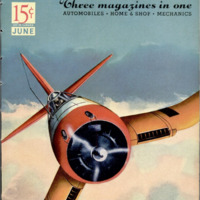 Popular Science Monthly, v. 138, n. 6, 1941
Popular Science Monthly, v. 138, n. 6, 1941

